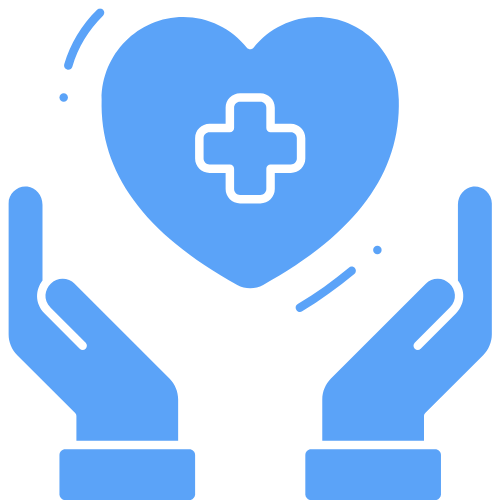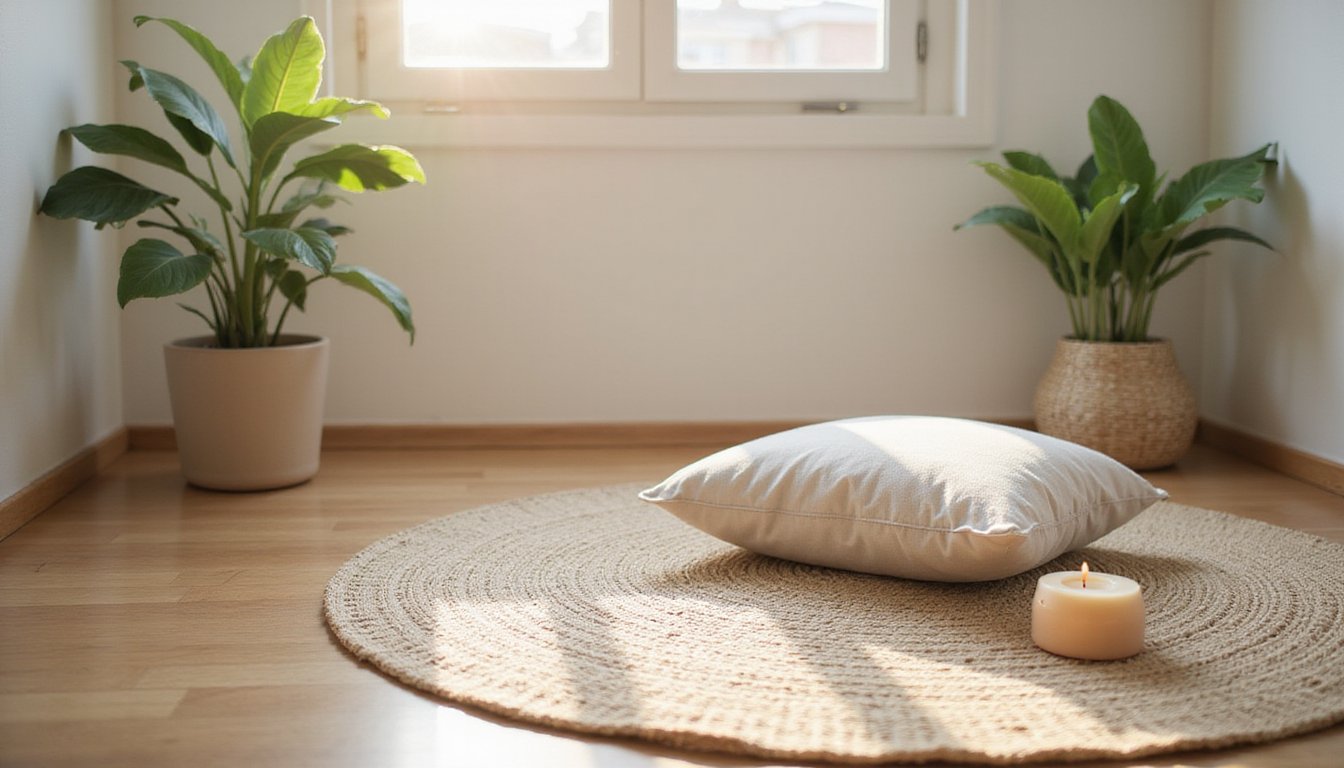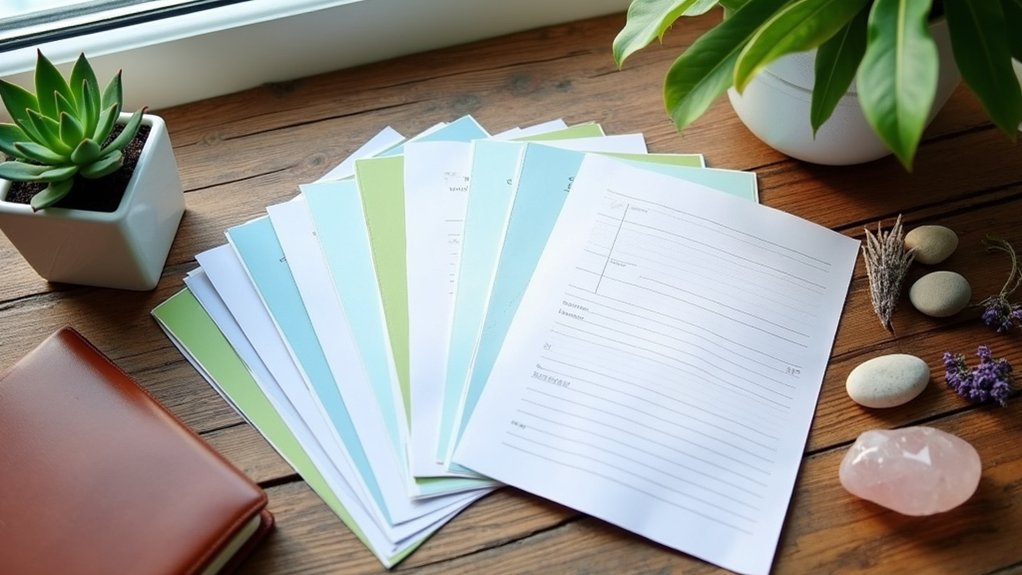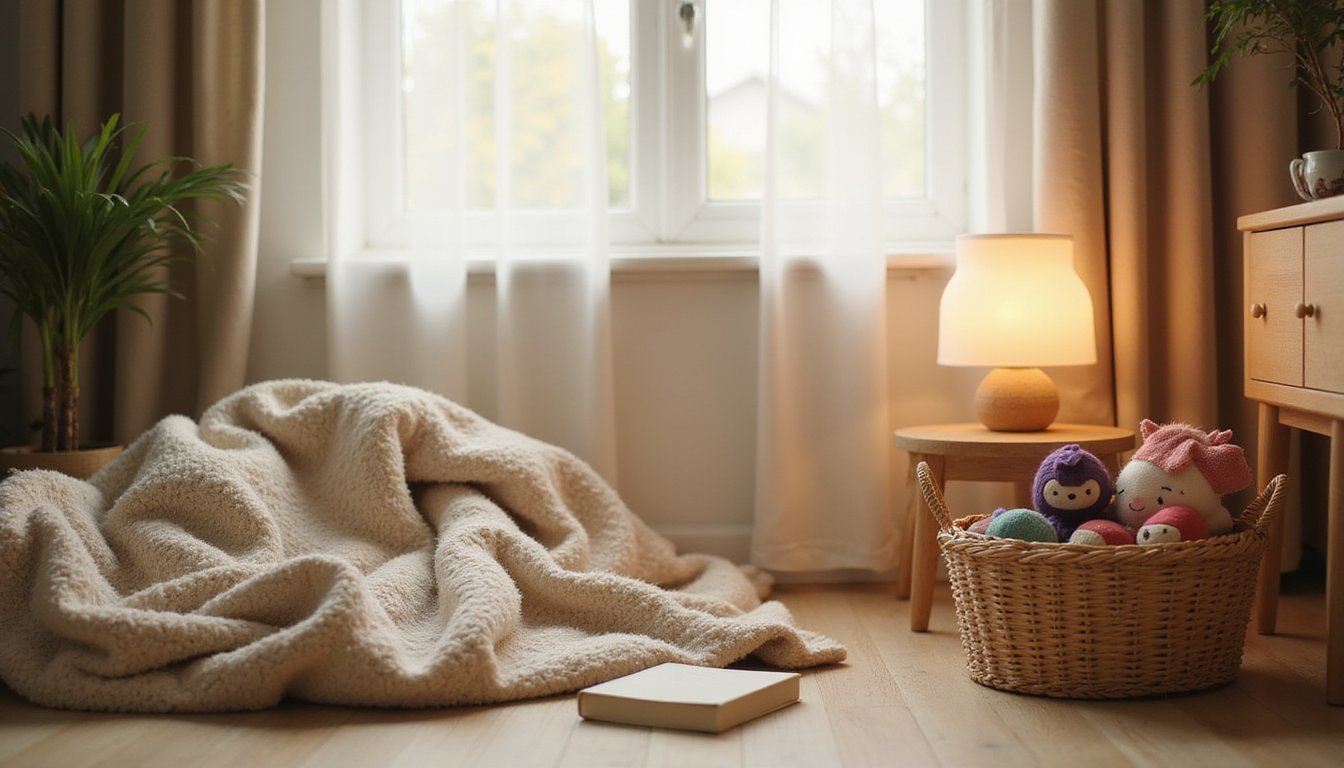Managing anxiety means you’ll need to take specific daily actions to reduce your symptoms and improve your functioning. You’ll learn to identify your unique anxiety signals, understand your personal triggers, and develop consistent coping habits like proper sleep, exercise, and breathing techniques. Working with mental health professionals can provide evidence-based strategies, while building a personalized toolkit helps you handle anxious moments effectively. These practical steps form the foundation for long-term anxiety management success.
Understanding Your Personal Anxiety Signals

Recognizing your unique anxiety signals serves as the foundation for effective anxiety management. When you understand personal triggers and anxiety patterns, you’ll be better equipped to implement targeted coping strategies.
Your body communicates anxiety through physical manifestations like increased heart rate, muscle tension, and gastrointestinal disturbances. Meanwhile, your mind may exhibit signs through persistent worry, difficulty concentrating, or excessive self-criticism. Behavioral changes, such as avoidance or compulsive actions, often accompany these symptoms. A typical panic episode will last between 5 and 30 minutes when it occurs. If left untreated, anxiety can lead to serious complications like depression or substance abuse.
Pay attention to disruptions in your sleep patterns and energy levels, as these can profoundly impact your anxiety levels. Watch for symptoms that persist beyond a few days or interfere with your daily functioning. Identifying whether you experience chronic anxiety versus temporary stress can help determine if professional support is needed. By monitoring these signals systematically, you’ll develop a clearer understanding of your anxiety’s unique presentation and progression.
Breaking Down Your Anxiety Triggers
Now that you can identify your personal anxiety signals, the next step involves mapping out specific triggers that set your anxiety in motion. Research shows that identifying specific triggers and monitoring trigger patterns can substantially improve your ability to manage anxiety responses effectively.
Identifying and tracking anxiety triggers creates a roadmap for better managing your emotional responses and maintaining mental wellness.
Common triggers fall into distinct categories that you’ll want to examine in your daily life:
- Environmental stressors (workplace deadlines, interpersonal conflicts, organizational changes)
- Social situations (public events, unfamiliar settings, group interactions)
- Personal trauma reminders (specific locations, sounds, or sensory experiences)
- Chronic stress factors (work-life balance issues, relationship difficulties, health concerns)
Understanding these patterns becomes particularly vital since data indicates that women experience stress-triggered anxiety at nearly twice the rate of men, and younger adults (ages 25-34) report the highest levels of workplace-related anxiety. Recent data shows that people aged 70 and over are significantly less likely to experience anxiety compared to other age groups. Studies reveal that individuals often delay seeking help, with 36% of people experiencing anxiety symptoms for over a decade before pursuing treatment. Working with a mental health professional to explore your anxiety triggers can help you develop effective coping mechanisms for long-term management.
Daily Habits That Make a Difference

While managing anxiety requires a multifaceted approach, implementing specific daily habits can considerably reduce symptoms and enhance your overall resilience. According to research, restoring pre-disaster routines helps reduce psychological distress. Prioritize 7-9 hours of consistent sleep by establishing relaxing routines before bedtime and maintaining regular wake times. Incorporate physical activity into your schedule, as exercise releases endorphins that naturally combat anxiety. Practice mindfulness through brief meditation or breathing exercises to improve your emotional regulation. Reaching out to trusted connections when feeling overwhelmed provides essential emotional support and perspective.
Structure your day with predictable patterns to minimize decision fatigue, and include rewarding activities like hobbies or social interactions. These intentional habits create protective barriers against stress while strengthening your coping resources. Even small adjustments, such as morning stretches or scheduled breaks for deep breathing, can notably impact your anxiety management when practiced consistently.
The Role of Professional Support
Professional support offers a powerful foundation for managing anxiety through evidence-based interventions and specialized expertise. When you engage with trained healthcare professionals, you’ll benefit from proven therapeutic approaches that consistently demonstrate high success rates in anxiety reduction. Specialized staff training in evidence-based techniques guarantees you receive optimal care aligned with current best practices. Recent studies show that psychoeducation and relaxation can significantly improve anxiety symptoms. The intensive outpatient format delivers faster results through concentrated three-hour daily sessions.
Professional care provides proven strategies and expert guidance for anxiety management, backed by evidence-based methods and specialized training.
Treatment programs now incorporate computer-assisted CBT to help guide both clinicians and patients through the therapeutic process.
Key aspects of professional support include:
- Exposure therapy, showing 70-80% effectiveness in symptom reduction
- Cognitive Behavioral Therapy (CBT) delivering sustained improvements in functioning and quality of life
- Regular clinician contact to enhance treatment adherence and outcomes
- Systematic progress tracking using validated assessment tools
This structured approach, combined with comprehensive assistance from mental health nurses, therapists, and psychiatrists, provides you with a robust framework for managing anxiety while ensuring measurable progress toward your recovery goals.
Building Your Anxiety Management Toolkit

Building an effective anxiety management toolkit requires both essential daily coping strategies and a personalized treatment action plan that aligns with your specific triggers and symptoms. You’ll need to combine multiple evidence-based approaches, including sensory grounding tools, breathing techniques, cognitive strategies, and targeted distraction activities that work best for your situation. The parasympathetic response can be activated through various calming techniques to help regulate your nervous system. A key purpose is to include items that engage all five senses to effectively break the cycle of anxious thoughts. Consider keeping a comfort kit nearby when anxiety strikes in unexpected places or situations. By consistently practicing and refining these tools while tracking their effectiveness, you can develop a reliable system for managing anxiety when it arises.
Essential Daily Coping Strategies
Managing anxiety effectively requires an extensive set of daily coping strategies that you can draw upon when needed. By noticing emotional shifts early and prioritizing relaxation, you’ll be better equipped to prevent anxiety from escalating. Research demonstrates that consistent practice of evidence-based techniques can greatly reduce anxiety symptoms.
- Practice deep breathing exercises and mindfulness techniques daily to activate your body’s natural relaxation response
- Maintain healthy lifestyle habits, including regular exercise and balanced nutrition while limiting caffeine and alcohol
- Implement cognitive reframing to challenge catastrophic thoughts and develop more balanced perspectives
- Establish a structured routine that incorporates regular social connections and dedicated time for stress management activities
Anxiety and avoidance often create a harmful cycle where avoiding triggers provides temporary relief but ultimately reinforces anxious behaviors. These strategies, when applied consistently, form the foundation of successful anxiety management and emotional regulation.
Personalized Treatment Action Plans
While every individual experiences anxiety differently, creating a personalized treatment action plan serves as the cornerstone of effective anxiety management. By evaluating personal goals and customizing treatment approaches, you’ll develop a targeted strategy that addresses your specific anxiety triggers and symptoms.
| Component | Purpose | Implementation |
|---|---|---|
| Evaluation | Identify triggers | Track symptoms via journals |
| Goals | Set measurable targets | Focus on daily functions |
| Interventions | Match therapy type | Select evidence-based treatments |
| Support | Build safety net | Connect with trusted resources |
Your plan should integrate cognitive restructuring techniques, relaxation methods, and crisis management strategies. Regular monitoring helps track progress and adjust interventions as needed. Remember to establish clear check-in points with mental health professionals and maintain flexibility in your approach as your needs evolve over time.
Creating a Sustainable Self-Care Strategy
Building sustainable self-care into your daily routine starts with identifying small, manageable wellness habits you can consistently maintain, such as scheduled breathing exercises or brief meditation breaks. You’ll strengthen your anxiety management foundation by blocking specific times for mental health activities, whether it’s a 10-minute morning journal session or an afternoon walk. Setting clear personal boundaries around your self-care commitments, like protecting your sleep schedule or limiting work-related screen time, helps guarantee these essential practices remain a priority in your life.
Build Daily Wellness Habits
To create lasting relief from anxiety, a thorough self-care strategy must integrate five essential wellness pillars: physical activity, nutrition, sleep, mindfulness, and social connection. Research demonstrates that combining these elements creates a powerful foundation for mental wellness and resilience.
Build your daily habits around these evidence-based practices:
- Schedule 30 minutes of moderate exercise most days, incorporating both aerobic and resistance training
- Maintain consistent sleep cycles by establishing fixed wake and bedtime routines, aiming for 7-9 hours nightly
- Choose anti-inflammatory foods rich in omega-3s, whole grains, and fresh produce while practicing mindful eating
- Practice intentional digital detox periods throughout your day, replacing screen time with brief mindfulness exercises or social connections
These interventions work synergistically, with each habit reinforcing and amplifying the benefits of the others.
Schedule Mental Health Breaks
Research demonstrates that scheduling regular mental health breaks throughout your day serves as a cornerstone of sustainable anxiety management. Studies show that micro-breaks of 5-10 minutes improve mental health outcomes for nearly half of adults, with significant boosts in vigor and reductions in fatigue.
When planning break frequency, use tools like the Pomodoro Technique, taking five-minute pauses after every 25 minutes of focused work. Set calendar reminders to guarantee you don’t skip these essential recovery periods. Integrating movement during breaks, such as stretching or walking, amplifies both physical and mental benefits. For high-stress or cognitively demanding tasks, consider extending breaks beyond 10 minutes. This structured approach to breaks reduces stress biomarkers, enhances emotional regulation, and prevents burnout, ultimately supporting your long-term mental wellness goals.
Set Achievable Personal Boundaries
Setting achievable personal boundaries forms the foundation of effective anxiety management and sustainable self-care. Through consistent limit enforcement and boundary maintenance, you’ll develop resilience against anxiety triggers while preserving your emotional energy.
Start implementing boundaries with these evidence-based strategies:
- Track boundary violations in a journal to identify recurring patterns that contribute to your anxiety levels
- Practice clear, direct communication using IF-THEN statements to establish consequences for crossed boundaries
- Begin with small, manageable boundaries like declining non-essential commitments or setting communication limits
- Respond to violations promptly with calm assertion, avoiding justification or over-explanation of your established limits
Seek professional support through therapy or counseling if you encounter persistent difficulty maintaining boundaries, especially when complicated by chronic anxiety or past trauma.
Navigating Social Relationships During Anxious Times
While managing social relationships can be challenging for anyone, individuals experiencing anxiety face unique obstacles in their interpersonal interactions. Your focus should be on cultivating meaningful connections with close family and friends who can provide consistent support and understanding during anxious periods.
When traversing remote social interactions, you’ll benefit from positive online engagements while being mindful of excessive social comparison or problematic social media use. Pay attention to how different types of interactions affect your anxiety levels, connections with familiar people typically cause less distress than those with unfamiliar individuals. Remember that your perception of social exchanges might be more negative than reality, especially during anxious times. Prioritize relationships that offer genuine support, as these connections can effectively buffer against stress and help reduce anxiety symptoms during social situations.
Reshaping Thought Patterns for Better Control
The way you think directly influences how you experience and respond to anxiety. By learning to identify and challenge cognitive distortions, you can reshape anxious thought patterns through structured techniques and constructive self-talk. Research-supported cognitive restructuring methods, combined with prioritizing relaxation practices, can substantially reduce anxiety’s impact on your daily life.
Key strategies for reshaping anxious thoughts include:
- Maintain a thought record to track and evaluate automatic negative reactions
- Practice evidence-based questioning to challenge catastrophic predictions
- Utilize mindfulness techniques to observe thoughts without immediate reaction
- Implement regular behavioral experiments to test and disprove anxious assumptions
These cognitive restructuring approaches, core components of CBT, demonstrate proven effectiveness in managing various forms of anxiety, from social situations to general worry patterns.
Physical Activities That Combat Anxiety
Physical movement stands as one of the most potent natural interventions for managing anxiety symptoms. You’ll find significant relief through regular aerobic exercise, with as little as five minutes of activity triggering anti-anxiety effects. Practicing moderate-intensity activities 3-5 times weekly offers ideal benefits, releasing fundamental neurochemicals like serotonin and GABA.
Mind-body practices, including yoga and creative movement therapies, combine physical activity with breath control to enhance your emotional resilience. Consider incorporating therapeutic outdoor pursuits, as exercising in green spaces amplifies anxiety reduction compared to indoor environments. Whether you choose brisk walking, swimming, or dancing, consistency matters more than intensity. Research shows that maintaining a regular exercise routine over several weeks produces more stable improvements in anxiety symptoms than sporadic activity.
Making Workplace Adjustments for Anxiety Management
Building on effective anxiety management strategies, workplace accommodations play a central role in supporting employees who experience anxiety. Employee accommodations can substantially improve your work experience and performance reviews while managing anxiety symptoms effectively.
Workplace accommodations are vital tools that empower anxious employees to thrive while effectively managing their symptoms in professional settings.
Research shows that workplace adjustments yield tangible benefits for both employees and organizations, with 71% of employers reporting increased productivity. You’ll find several evidence-based accommodations that can help:
- Flexible scheduling options for therapy appointments and gradual return-to-work programs
- Environmental modifications, including quiet spaces and noise reduction solutions
- Regular check-ins with managers and access to job coaches for real-time support
- Clear accommodation request processes that comply with ADA requirements
These adjustments create a supportive environment that reduces disability claims, shortens return-to-work durations, and promotes overall workplace well-being.
Frequently Asked Questions
How Can I Help My Child Understand and Manage Their Anxiety?
Help your child identify anxiety symptoms through open conversations and teach them calming breathing techniques like belly breathing or counting breaths. Introduce positive self-talk strategies by replacing worrying thoughts with helpful ones. Model these coping skills yourself and praise their efforts when they use them. Create a supportive environment where they can express their fears, and consistently reinforce that anxiety is both common and manageable through practice.
Can Anxiety Symptoms Be Different Between Men and Women?
Yes, anxiety symptoms can differ markedly between men and women. You’ll notice that women typically experience more intense panic symptoms and are prone to avoidance behaviors, while men often turn to substance use to cope. These differences stem from both hormonal differences and social expectations. Women are also more likely to develop comorbid depression or eating disorders, while men frequently show anxiety alongside ADHD or substance use disorders.
What Role Does Genetics Play in Developing Anxiety Disorders?
Your genetic predisposition plays a significant role in developing anxiety disorders, accounting for 30-50% of your risk. You inherit these tendencies through multiple genes that interact with environmental influences like stress, trauma, or life experiences. If you have a first-degree relative with anxiety, you’re more likely to develop the condition. However, having genetic risk factors doesn’t guarantee you’ll develop anxiety, your lifestyle and experiences also shape its manifestation.
How Long Should I Try Non-Medication Approaches Before Considering Prescription Treatment?
You should typically try non-medication approaches for 6 to 12 weeks before considering prescription treatment. During this trial duration, you’ll want to consistently engage in therapies like CBT or mindfulness-based stress reduction. If you’re experiencing moderate to severe symptoms that don’t improve after this period, or if your daily functioning is considerably impaired, you may want to discuss medication efficacy with your healthcare provider. Studies show non-medication approaches can be as effective as medications when properly implemented.
Are There Specific Cultural Factors That Influence Anxiety Management Effectiveness?
Yes, cultural factors substantially impact how you manage anxiety effectively. Cultural stigmas associated with mental health can affect your willingness to seek treatment, while societal pressures contributing to anxiety vary across cultures. You’ll find that family dynamics, collectivistic versus individualistic values, and traditional beliefs all shape your response to different interventions. Research shows you’ll achieve better outcomes when using culturally adapted treatments that align with your background and beliefs.
















